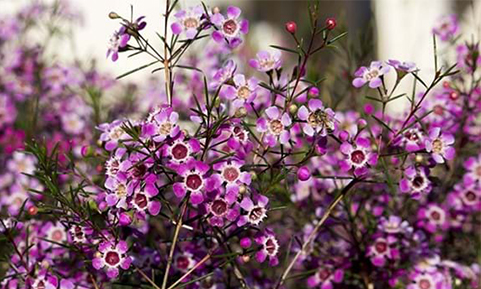Geraldton Wax is one of Australia’s most significant cut wildflower exports due to its beauty, longevity. The bush grows from .5 to 4m high. It has a long flowering season, bringing vivid colour to the landscape mostly from late winter to spring. The Chamelaucium spp. flowers range from purple, pink to white, and the green leaves are narrow and contain oil glands giving the leaves a ‘waxy’ feel.
As a member of the Myrtaceae family, just like the Eucalyptus and Syzygium (lilly pilly) spp. it is rich in essential oil. Native to Western Australia, GW grows quickly, can thrive in poor soil, prefers less water and dry climate. A strong, generous 5 petalled flower with an open nectar bowl requires no bee acrobatics or special tricks to pollinate, many insects and flies . The urban Bushland Council in WA Inc notes that Geraldton Wax can be a highly invasive weed, degrading the banksia landscape .
The oil is easily released when crushed or heated and the pungent smell is sweet. GW is currently on trend in cooking adding a citrusy flavour to food. When chewed it gives a lovely, bright aromatic lemony buzz. Like a cross between lemon verbena, lemon grass and lemon/lime citrus zest, with a definite bush aftertaste. A slightly numbing, cleansing pleasing bite.
The major compounds have been identified as a-pinene, citronellal, limonene, linalool and a-terpinyl acetate , already known to have antifungal, antiseptic, antibacterial, anti inflammatory properties. These and other active principals are found in eucalyptus, ti tree, clove and herbs such as rosemary and lavender.
Due to the importance of Geraldton Wax as a cut flower export, a lot of scientific research has been carried out. Studies by L.A. Terry et al (2003) show that four antifungal compounds are part of the GW flower profile . This antifungal activity protects flowers from pathogens and helps maintain the longevity of the bloom for the international market.


